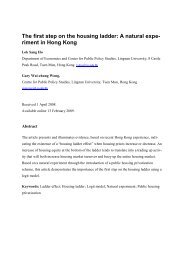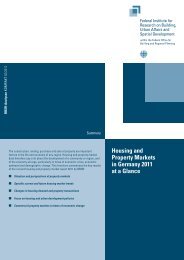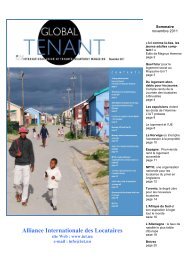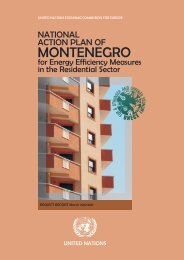housing developments in european countries - Department of ...
housing developments in european countries - Department of ...
housing developments in european countries - Department of ...
Create successful ePaper yourself
Turn your PDF publications into a flip-book with our unique Google optimized e-Paper software.
Section 2<br />
Context<br />
Context Section 2<br />
Table<br />
2.25.2<br />
Economic Trends <strong>in</strong> Slovenia, 1995-2002<br />
2.26 Spa<strong>in</strong><br />
requirements, <strong>in</strong>clud<strong>in</strong>g: a limited useful surface<br />
(maximum 90 m2) and a limited price per m 2 ;<br />
Category 1995 1996 1997 1998 1999 2000 2001 2002<br />
% % % % % % % %<br />
Change <strong>in</strong> GDP at constant (1995) prices 4.1 3.6 4.8 3.6 5.6 3.9 2.7 3.4<br />
Change <strong>in</strong> the harmonised <strong>in</strong>dex <strong>of</strong> consumer prices Nav 9.9 8.3 7.9 6.1 8.9 8.6 Nav<br />
Unemployed persons as a % <strong>of</strong> the labour force Nav 6.9 6.9 7.4 7.2 6.6 5.8 Nav<br />
2.25.3 Economy<br />
TABLE 2.25.2 provides details <strong>of</strong> recent economic<br />
trends <strong>in</strong> Slovenia. It reveals a slow-down <strong>in</strong> the rate <strong>of</strong><br />
<strong>in</strong>crease <strong>in</strong> GDP , from 5.6% <strong>in</strong> 1999 to 3.4% <strong>in</strong><br />
2002, and a persistently high rate <strong>of</strong> <strong>in</strong>flation as<br />
compared to more long-stand<strong>in</strong>g members <strong>of</strong> the EU.<br />
The unemployment rate <strong>in</strong> this country is significantly<br />
lower than the average for the new 8 CEE <strong>countries</strong><br />
which jo<strong>in</strong>ed the EU <strong>in</strong> 2004<br />
2.25.4 Demography<br />
TABLE 2.25.3 demonstrates that <strong>in</strong> 2002, the total<br />
population <strong>of</strong> Slovenia stood at 1,964,036 persons and<br />
684,847 households. The average number <strong>of</strong> persons<br />
per household was 2.8 <strong>in</strong> 2002, and 55.5% <strong>of</strong> all<br />
households <strong>in</strong>cluded more than 3 persons. On average<br />
households liv<strong>in</strong>g <strong>in</strong> apartments or high-rise dwell<strong>in</strong>gs<br />
are slightly smaller <strong>in</strong> size. Only 48.6% <strong>of</strong> the<br />
households so accommodated <strong>in</strong>cluded 3 or more<br />
persons <strong>in</strong> 2002.<br />
Table<br />
2.25.3<br />
Category<br />
Demographic Trends <strong>in</strong> Slovenia,<br />
1995-2020<br />
Population No. 1,964,036<br />
Private households No. 684,847<br />
Average number <strong>of</strong> persons<br />
per household No. 2.8<br />
1 person households % 21.4<br />
2 person households % 23.1<br />
3 person households % 21.1<br />
4 person households % 23.2<br />
5 or more person households % 11.2<br />
2.26.1 Policy Mak<strong>in</strong>g and<br />
Implementation<br />
Although Spa<strong>in</strong> is not a federal State, the Spanish<br />
constitution divides the country <strong>in</strong>to 18 autonomous<br />
regions and cities with political, adm<strong>in</strong>istrative and<br />
judicial powers. Moreover, the constitution affords<br />
these regions and cities significant political and<br />
adm<strong>in</strong>istrative <strong>in</strong>dependence <strong>in</strong> the <strong>hous<strong>in</strong>g</strong> field.<br />
Therefore <strong>in</strong> Spa<strong>in</strong>, central government has no specific<br />
rights or responsibilities <strong>in</strong> the <strong>hous<strong>in</strong>g</strong> field. However,<br />
central government’s responsibilities <strong>in</strong> relation to<br />
national economic and plann<strong>in</strong>g policy mean that it<br />
plays a role <strong>in</strong> the <strong>hous<strong>in</strong>g</strong> field because <strong>hous<strong>in</strong>g</strong> is<br />
very important to the national economy. As a result<br />
central government has <strong>in</strong>troduced several <strong>hous<strong>in</strong>g</strong><br />
f<strong>in</strong>anc<strong>in</strong>g schemes s<strong>in</strong>ce the ratification <strong>of</strong> the Spanish<br />
constitution <strong>in</strong> 1978. The autonomous regions have<br />
devised their own <strong>hous<strong>in</strong>g</strong> policies, which <strong>in</strong>volve<br />
various levels <strong>of</strong> public fund<strong>in</strong>g.<br />
Central government utilises two pr<strong>in</strong>cipal <strong>in</strong>struments<br />
to contribute to the f<strong>in</strong>anc<strong>in</strong>g <strong>of</strong> <strong>hous<strong>in</strong>g</strong>: fiscal<br />
measures and State <strong>hous<strong>in</strong>g</strong> f<strong>in</strong>anc<strong>in</strong>g plans. The fiscal<br />
measures <strong>in</strong>directly <strong>in</strong>fluence the behaviour <strong>of</strong> both<br />
developers and buyers <strong>of</strong> <strong>hous<strong>in</strong>g</strong>. The ma<strong>in</strong> measures<br />
<strong>of</strong> this sort that are employed are: value added tax<br />
(VAT) and <strong>in</strong>come tax. In general these fiscal<br />
<strong>in</strong>struments do not take account <strong>of</strong> the <strong>in</strong>come levels<br />
<strong>of</strong> buyers, except<strong>in</strong>g some cases such as additional VAT<br />
reductions <strong>in</strong> the case <strong>of</strong> certa<strong>in</strong> dwell<strong>in</strong>gs for low<strong>in</strong>come<br />
families.<br />
In contrast, the State <strong>hous<strong>in</strong>g</strong> f<strong>in</strong>anc<strong>in</strong>g plans are<br />
applied <strong>in</strong> a more targeted manner that takes account<br />
<strong>of</strong> the <strong>in</strong>come levels and other characteristics <strong>of</strong><br />
beneficiaries. The key features <strong>of</strong> these f<strong>in</strong>anc<strong>in</strong>g plans<br />
are as follows:<br />
■ central government determ<strong>in</strong>es which type <strong>of</strong><br />
dwell<strong>in</strong>gs, activities, or recipients will be targeted;<br />
■ <strong>in</strong> relation to <strong>of</strong>ficially protected dwell<strong>in</strong>gs, <strong>in</strong> order<br />
to be granted this status by the authorities <strong>of</strong> the<br />
autonomous regions, they must fulfil certa<strong>in</strong><br />
■ to date, supports for the follow<strong>in</strong>g types <strong>of</strong><br />
development have been provided:<br />
– the development <strong>of</strong> new <strong>of</strong>ficially protected<br />
dwell<strong>in</strong>gs by private as well as public<br />
organisations for sale or rent; <strong>in</strong> practice most<br />
dwell<strong>in</strong>gs are developed by the private sector and<br />
<strong>in</strong> the case <strong>of</strong> rented dwell<strong>in</strong>gs, the government<br />
<strong>in</strong>centives go to the developer, not to the tenants,<br />
although the latter has the advantage <strong>of</strong> the<br />
capped rents which must be charged on<br />
<strong>developments</strong> <strong>of</strong> this type;<br />
– the purchase <strong>of</strong> these <strong>of</strong>ficially protected dwell<strong>in</strong>gs,<br />
as well as other exist<strong>in</strong>g dwell<strong>in</strong>gs, which must<br />
fulfil the aforementioned requirements <strong>in</strong> relation<br />
to size and price;<br />
– refurbish<strong>in</strong>g <strong>in</strong>ner city areas, as well as certa<strong>in</strong><br />
other build<strong>in</strong>gs and dwell<strong>in</strong>gs and avail<strong>in</strong>g <strong>of</strong><br />
central government aids <strong>of</strong> this type; this usually<br />
<strong>in</strong>volves an agreement between local and regional<br />
government, together with an agreement between<br />
the latter and central government regard<strong>in</strong>g the<br />
<strong>in</strong>clusion <strong>of</strong> the area <strong>in</strong> the regional targets with<strong>in</strong><br />
the national <strong>hous<strong>in</strong>g</strong> plan;<br />
– provid<strong>in</strong>g sites for the construction <strong>of</strong> all types<br />
<strong>of</strong> <strong>of</strong>ficially protected dwell<strong>in</strong>gs;<br />
■ central government plans also determ<strong>in</strong>e the type,<br />
level and timeframe <strong>of</strong> the public aid available for<br />
each type <strong>of</strong> protected dwell<strong>in</strong>g and target recipient<br />
group;<br />
■ the public aid consists <strong>of</strong> qualified loans (from<br />
sav<strong>in</strong>gs banks and commercial banks), together with<br />
subsidies towards the cost <strong>of</strong> these loans and<br />
provision <strong>of</strong> <strong>hous<strong>in</strong>g</strong> allowances by central<br />
government, and<br />
■ the State <strong>hous<strong>in</strong>g</strong> f<strong>in</strong>anc<strong>in</strong>g plans are implemented<br />
and managed by means <strong>of</strong> agreements with the<br />
autonomous regions and the other f<strong>in</strong>anc<strong>in</strong>g<br />
organisations – agreements with the autonomous<br />
regions generally last four years; dur<strong>in</strong>g this period,<br />
a variety <strong>of</strong> targets, relat<strong>in</strong>g to the number <strong>of</strong><br />
dwell<strong>in</strong>gs to be constructed or refurbished, must be<br />
reached <strong>in</strong> order to access the loans, subsidies and<br />
<strong>hous<strong>in</strong>g</strong> allowances.<br />
76 European Union Report<br />
Regular National Report on Hous<strong>in</strong>g Developments <strong>in</strong> European Countries<br />
77

















